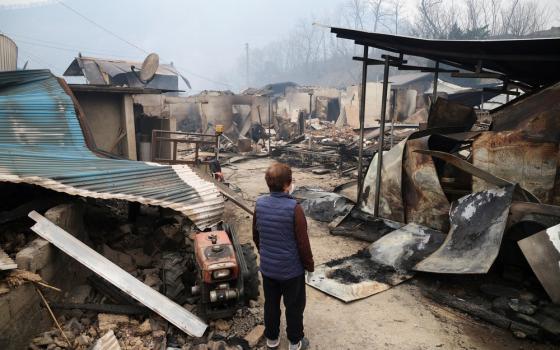
PHILADELPHIA – Do you know what Web 2.0 is? If not, “Google,” said Sr. Caroline Cerveny.
In a talk on “Catechetics in the 21st Century,” Cerveny said there are hundreds of ways that parishes and their religious education programs can take advantage of Internet interactive computer and mobile device technology to advance their ministry.
Computers and mobile devices are about communication, interaction and relationships, and should be an integral part of life in today’s parish and its religious education programs, said Cerveny, a Sister of St. Joseph, Third Order of St. Francis.
Unfortunately, she added, in most parish religious education programs “teachers don’t have the training or the funds” to obtain such technological tools or use them effectively.
She suggested four levels of technology use for religious education:
- Basic: a computer, screen, LCD projector and speakers.
- Cyber: the basic elements plus an Internet connection.
- Interactive: the basics and Internet plus SMART Board, an interactive whiteboard for classroom use.
- Participatory: Interactive plus a computer lab or portable computers or mobile devices.
 Cerveny and other speakers at a daylong parish technology summit Feb. 25 at Villanova University in Philadelphia offered a variety of ways that parishes can use today’s computer technology and electronic mobile devices to advance their mission and ministry, especially among youths and young adults. The summit was organized by the university’s Center for the Study of Church Management.
Cerveny and other speakers at a daylong parish technology summit Feb. 25 at Villanova University in Philadelphia offered a variety of ways that parishes can use today’s computer technology and electronic mobile devices to advance their mission and ministry, especially among youths and young adults. The summit was organized by the university’s Center for the Study of Church Management.
Among suggestions the speakers raised were:
- Use Internet resources for religious education and sacramental preparation.
- Put weekly bulletins, announcements and other parish news on the Web.
- Put an electronic registration link on the home page of your parish Web site, inviting newcomers to join the parish and to submit e-mail and other contact information for follow-up.
- Use webinars (Web seminars), blogs and other interactive Internet tools to replace tedious informational meetings, allowing busy parishioners to participate from home instead of spending an evening at the parish hall.
- Use Web resources already out there for everything from daily scripture readings and meditation to Bible study, religious education and sacramental preparation.
- Encourage electronically linked prayer groups.
- Set and publicize volunteer ministry schedules, such as those for readers, greeters and eucharistic ministers at Mass, through the Web.
- Use free and open-source software from the Web to create presentations and to edit images and video. Or even design classroom presentations from www.moodle.net, a free Web site created to help teachers exploit the educational possibilities of Internet technology.
Cerveny noted that Web 2.0 -- which garners 382 million hits in a Google search -- is not a new Internet but a term coined to reflect the increasingly easy social networking, sharing, two-way communication, collaboration and global reach, all made possible by advances in Internet-based technology, that are shaping the way youths and young adults communicate.
Think Facebook, YouTube, Flickr, MySpace or what has become the world’s most massive and accurate encyclopedia, Wikipedia.
Cerveny is president of Interactive Connections, which she founded recently to promote better Internet technology use in religious education and pastoral outreach. She invited Villanova participants involved in religious education to join www.digitalcatechesis.ning.com, a Web network of people working to advance effective use of technology in all areas of faith formation.
 Notre Dame Sr. Susan Wolf noted that according to a recent Pew study, 93 percent of American teenagers and young adults have access to the Internet. Those numbers decline among people over 30, dropping to 38 percent among those over 65, she said.
Notre Dame Sr. Susan Wolf noted that according to a recent Pew study, 93 percent of American teenagers and young adults have access to the Internet. Those numbers decline among people over 30, dropping to 38 percent among those over 65, she said.
Describing the rapidly expanding use of the Internet for church ministry and mission, she said that when she left parish ministry in Ohio in 2005 to join the Paulist National Catholic Evangelization Association in Washington, the association began its first online newsletter.
She said Paulist quarterly webinars for diocesan directors of evangelization attracted an average of about 50 people in the first year, but now they average about 600 people representing more than half the dioceses in the country.
Cerveny urged digital immigrants (age 40 and up) to get help from digital natives, those under 40 who grew up with computer technology, if they feel unable to cope with the growing flood of mobile devices and Internet applications that teenagers take for granted.
She showed a video clip of excited fifth-graders working together on a project with computers and mobile devices. “When did your religious ed class have that much fun?” she asked.
In a conversation with NCR between presentations, two speakers from diocesan offices for youth and young adult ministry -- Scott Miller of Baltimore and Paul Jarzembowski of Joliet, Ill. -- said that advances in Internet communication offer the church both new opportunities and challenges.
Miller said there is a vast field of resources available on the Web that can be tapped just by creating hyperlinks on a diocesan Web site. He cited the sources for spiritual reflection on Lent put out by the U.S. Conference of Catholic Bishops (www.usccb.org) as one example. He also said his archdiocesan youth and young adult ministry office (www.archbalt.org/young church) marked the papally proclaimed year of priests by posting a series of videos by young people saying what they liked about their parish priests.
Support independent Catholic journalism. |
“This is about relationships,” Jarzembowski said of the new networking capabilities on the Internet. “Now people can communicate back” when they receive an announcement from their parish.
Wolf warned that technology is “a tool, not a cure” and that a lack of hospitality in a parish or a self-centered community will not improve just because they make better use of technology.
Miller struck a similar note when he warned about “false intimacy” on the Internet, saying that sending condolences on Facebeook about someone’s death is not really the same as attending the wake or funeral of the dead person and interacting personally with his or her relatives.
Technology can help Catholics sideline unimportant meetings and “concentrate on the important stuff ... keeping focused on worship and ministry,” he said, but he added that such an approach will work only if we steer them toward that primary focus on worship, mission and ministry.
[Jerry Filteau is NCR Washington correspondent.]
Stories in this parish series
|




